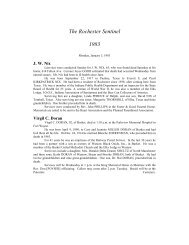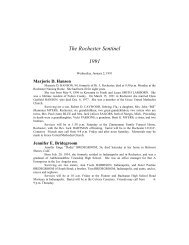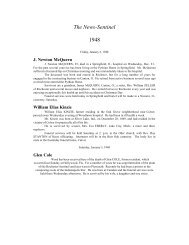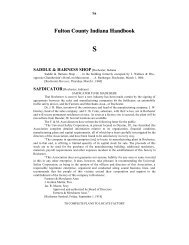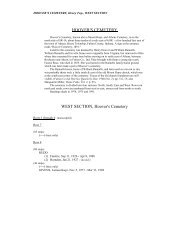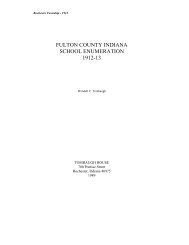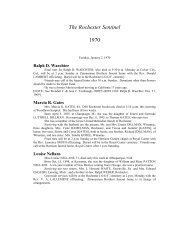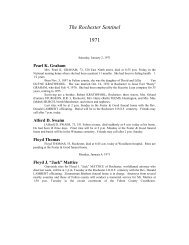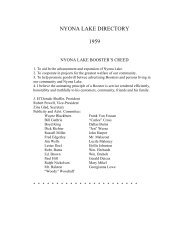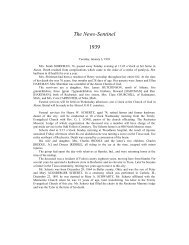Handbook N-P - Fulton County Public Library
Handbook N-P - Fulton County Public Library
Handbook N-P - Fulton County Public Library
You also want an ePaper? Increase the reach of your titles
YUMPU automatically turns print PDFs into web optimized ePapers that Google loves.
Pr<br />
The remains have aroused much discussion and several people first thought that it was<br />
part of the skeleton of a Mastodon or a Dinortherium, but their theories were disapproved today.<br />
James Hoover came into the Sentinel office, examined the relics, and at once said that it was the<br />
remains of a Mammoth. The size and structure of the teeth proved his assertion.<br />
40,000 Years Old<br />
The Mammoth lived on this earth about 40,000 years ago, according to the best<br />
authorities, and inhabited the northern regions. In the year 1799 a full size Mammoth, in perfect<br />
state of preservation was dug out of the ice in Siberia. The one found had long hair over the body<br />
with a fine coat of redish wool next to the skin. Judging from the size of the teeth the one on<br />
exhibition at the Sentinel office was probably about six months old.<br />
[Rochester Sentinel, Monday, April 14, 1913]<br />
MORE BIG BONES ARE FOUND<br />
More bones, supposedly those of a mammoth or mastodon, have been unearthed by the<br />
A. C. Davisson dredge, which is now at work on the Rentschler ditch near <strong>Fulton</strong>.<br />
The bones were dug up in a swamp on the John Frye farm, southeast of <strong>Fulton</strong>, and<br />
consist principally of ribs full two inches wide, and what are thought to be leg bones, six inches in<br />
diameter. Frye himself picked them up after they had been dug out of their resting places, six feet<br />
under ground.<br />
It is two miles from this place to the Charles Yankee farm, where the jaw bones of a<br />
mammoth, exhibited in the Sentinel window, were found, and consequently it is hardly thought<br />
that the sets are part of one skeleton. Further investigation may be made of the find, which will be<br />
reported to Washington.<br />
[Rochester Sentinel, Thursday, July 24, 1913]<br />
STILL MORE BONES ARE FOUND<br />
Again has the Davisson dredge working on the Rentschler ditch, east of <strong>Fulton</strong>, unearthed<br />
bones of prehistoric animals, the machine this time throwing up a number of well preserved<br />
specimens presumably from the skeleton of a mastodon or mammoth.<br />
The bones were found in a swampy part of the Arthur Frye farm, two and one-half miles<br />
east of <strong>Fulton</strong>. Among them were a jaw bone, with teeth in it eight inches wide; a piece of tusk<br />
broken, but about half remaining and in good shape; thigh bone three feet long, smallest part 12<br />
inches around, largest part 29 inches around; hip bone, three feet long; and several other bones.<br />
The bones were picked up by Frye after the dredge had cast them out on the bank of the<br />
new ditch. They are valuable relics and were found three miles from the Yankee farm.<br />
[Rochester Sentinel, Saturday, August 2, 1913]<br />
BONES OF PREHISTORIC BEAST WERE UNCOVERED<br />
Several large bones of what is thought to have been a mastodon were uncovered several<br />
days ago on the farm of Robert Ewen six miles southwest of Rochester. The farm is better known<br />
as the Newburn farm.<br />
The bones were unearthed while Mr. Ewen and several men were digging a trench in<br />
which to place tile. The bones were under the earth’s surface but three feet.<br />
The tiling was done to drain a pot hole. It is believed that the huge animal in some<br />
prehistoric day was either feeding or drinking water at the point where some earth transformation<br />
took place which either killed or trapped him.<br />
Several vertabrae have been uncovered as has a large bone from one of the limbs. This<br />
bone was some five feet long. What is thought to have been a knee joint has also been unearthed.<br />
It was a foot in diameter.<br />
In years gone by a number of mastodons have been found west of Rochester and<br />
northwest of this city near Argos. The last such discoveries were made four years ago near Argos<br />
by a farmer.




